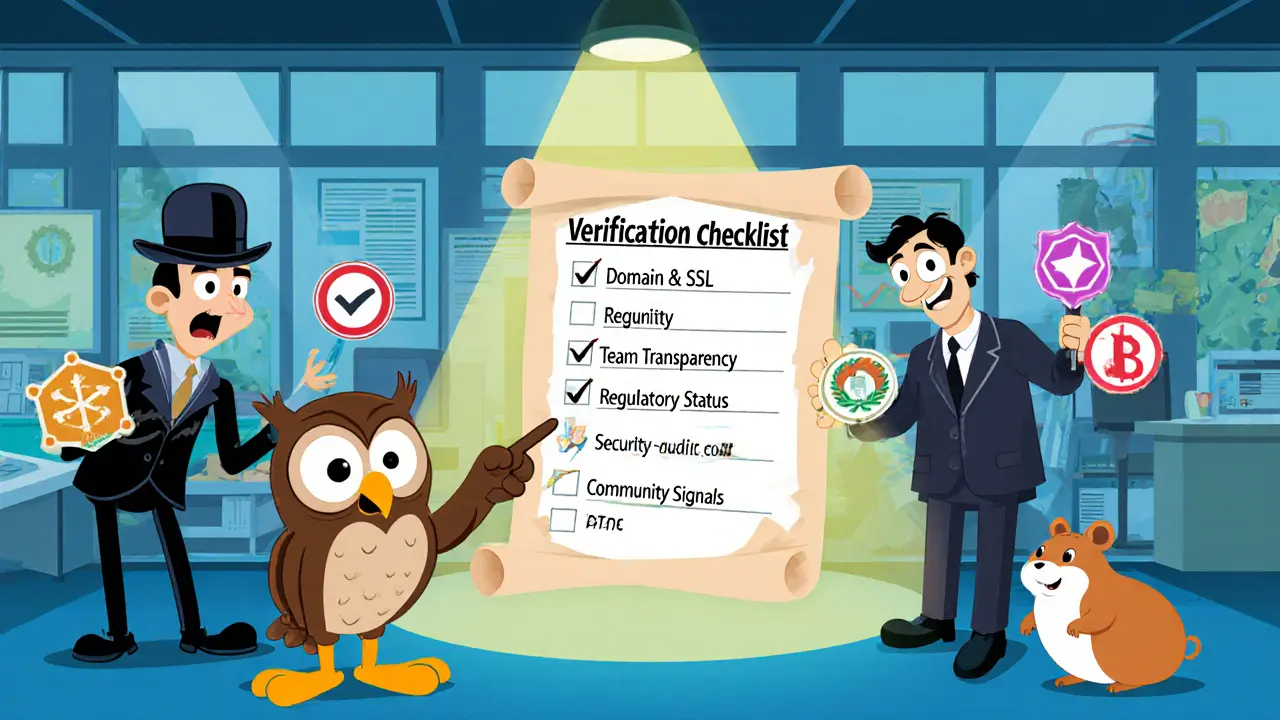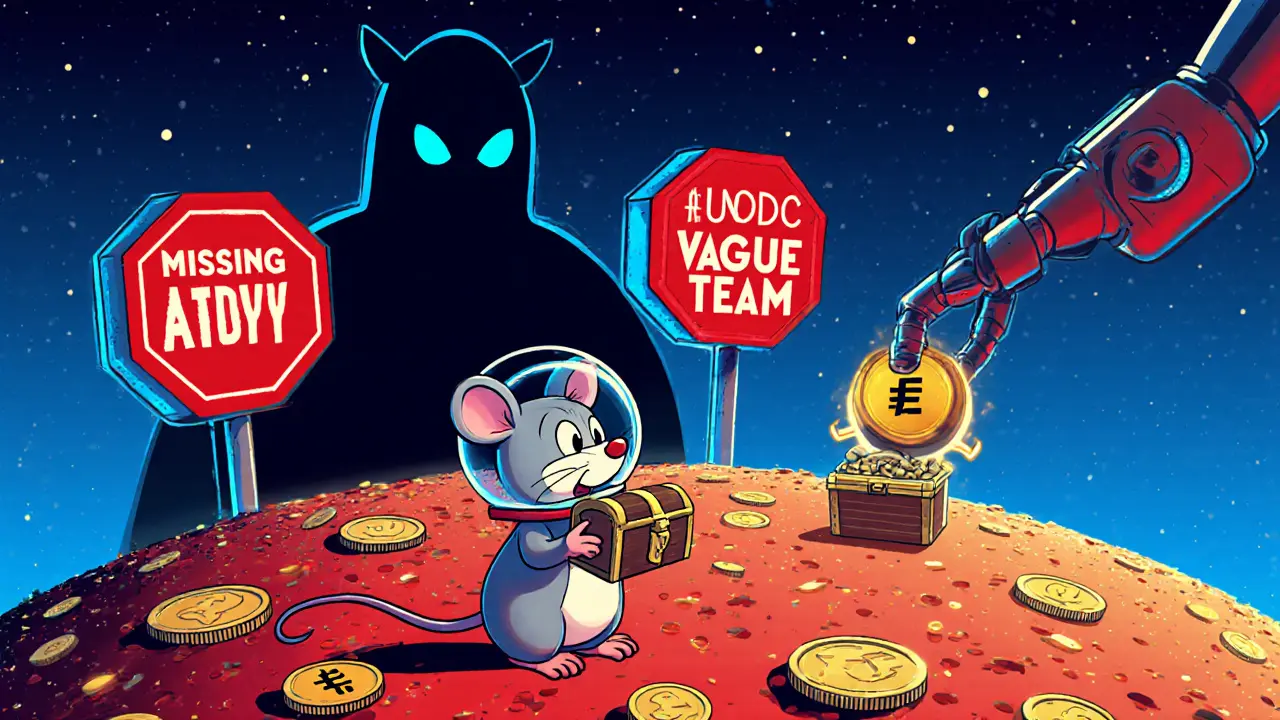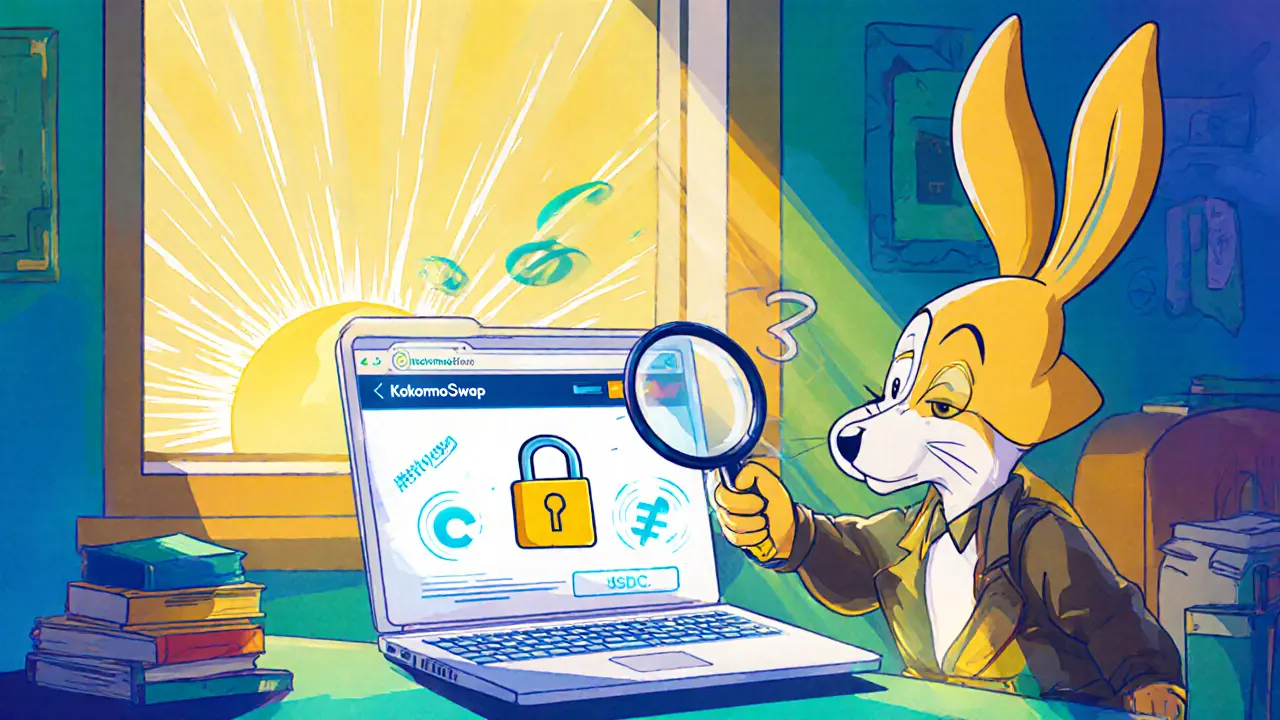Key Takeaways
- KokomoSwap is a new or low‑profile platform, so independent data is scarce.
- When evaluating any exchange, check licensing, security audits, and fee transparency.
- Largest 2025 exchanges (Binance, MEXC, Uniswap) set clear benchmarks for liquidity and support.
- Use a step‑by‑step verification checklist before moving funds to KokomoSwap.
- Consider starting with a small test deposit and keep backup wallets for security.
When looking at KokomoSwap you quickly notice that public reviews and third‑party analyses are hard to find. That lack of coverage can be a red flag, but it can also mean the platform is brand‑new or serves a niche market. This KokomoSwap crypto exchange review will walk you through the questions you should ask, the data points you can actually verify, and how the platform compares with the heavy‑hitters of 2025.
What Kind of Exchange Is KokomoSwap?
Crypto exchanges fall into four broad categories:
- Centralized exchanges (CEX) - run by a company that holds user assets.
- Decentralized exchanges (DEX) - smart‑contract‑based, users retain custody.
- Peer‑to‑peer (P2P) platforms - match buyers and sellers directly.
- Zero‑fee or low‑fee specialists - aggressively price trades.
Because the public information on KokomoSwap is limited, the safest assumption is that it positions itself as a decentralized exchange that leverages an existing blockchain (likely Ethereum or BNB Smart Chain). Most DEXs in 2025, such as Uniswap and PancakeSwap, provide on‑chain swaps, liquidity pools, and token launchpads. If KokomoSwap follows that model, you’ll be using a web‑based interface that interacts directly with your wallet (MetaMask, Trust Wallet, etc.).
How to Verify Legitimacy
Before you deposit any funds, run through this checklist:
- Domain & SSL - Ensure the URL uses HTTPS and matches the official branding on social media.
- Team Transparency - Look for an "About" page, LinkedIn profiles, or a reputable advisory board.
- Regulatory Status - Check if the platform is registered in a jurisdiction with clear crypto rules (e.g., EU, Singapore, Cayman Islands).
- Security Audits - Search for a public audit report from firms such as CertiK, Hacken, or Quantstamp.
- Community Signals - Scan Telegram, Discord, and Reddit for active users, response times, and any reported scams.
If any of these items are missing or vague, treat the exchange with caution. Established platforms like Binance and MEXC publish detailed compliance documents, making verification straightforward.
Fee Structure and Trading Costs
Fees are one of the first things users compare. In 2025, zero‑fee trading has become a competitive edge. MEXC offers 0% maker fees for spot and futures, while Binance provides free crypto‑to‑crypto conversions for over 400 coins.
If KokomoSwap is a DEX, the primary costs are network gas fees and a protocol fee (often 0.3% for swaps). Some newer DEXs compress fees to 0.05% by bundling multiple transactions. Without an official fee schedule, assume the standard 0.2‑0.3% on‑chain fee plus the underlying blockchain gas cost.

Liquidity and Trading Pairs
Liquidity determines slippage - the price impact of your trade. Uniswap’s Total Value Locked (TVL) sits above $4B, making it a safe bet for most ERC‑20 tokens. PancakeSwap leads BNB Smart Chain with a TVL of $2B.
To gauge KokomoSwap’s depth, check its public pool listings. Look for the amount of liquidity (in USD) attached to each pair and compare it with the same pair on Uniswap or PancakeSwap. If KokomoSwap shows $10K liquidity for a token that has $10M on Uniswap, expect noticeable slippage.
Security Track Record
Security breaches make headlines. In 2025, the biggest incidents involved smart‑contract exploits on lesser‑known DEXs. Platforms that undergo regular audits and have bug‑bounty programs tend to avoid such pitfalls.
Search for any recorded incidents involving KokomoSwap. A clean history is reassuring, but the absence of data could simply mean the platform is too new to have been attacked - both are ambiguous indicators.
Comparative Snapshot
| Feature | KokomoSwap | Binance | MEXC | Uniswap (DEX) |
|---|---|---|---|---|
| Type | Decentralized (presumed) | Centralized | Centralized | Decentralized |
| Supported Coins | Not publicly listed | 500+ (fiat on‑ramp) | 2,500+ | All ERC‑20 |
| Trading Fees | ~0.2‑0.3% + gas | 0.1% maker / 0.1% taker | 0% maker, 0.05% taker | 0.3% protocol fee |
| Liquidity (Avg. TVL) | Unclear / likely <$5M | $1B+ | $2B+ | $4B+ |
| Regulation | Not disclosed | Licensed in multiple jurisdictions | Licensed in several regions | Non‑custodial, no license needed |
| Audit Status | Not public | Annual audits (PwC) | Quarterly audits | Open‑source code, community audits |
The table shows that KokomoSwap currently lacks the transparency and scale of the biggest players. That doesn’t make it unusable, but it does raise the bar for your own due diligence.

Practical Steps to Get Started Safely
- Set up a hardware wallet (Ledger or Trezor) and keep your seed phrase offline.
- Visit the official KokomoSwap URL and verify SSL (padlock icon).
- Connect your wallet using the platform’s “Connect Wallet” button - ensure the popup is from the site itself, not a phishing clone.
- Do a “test trade”: swap a small amount (e.g., $20 worth of USDC for a low‑risk token) and monitor the transaction on the blockchain explorer.
- If the trade succeeds and the token lands in your wallet, gradually increase the amount while watching slippage and gas fees.
- Keep a separate “cold storage” wallet for the bulk of your holdings; only keep what you need for active trading on KokomoSwap.
When to Walk Away
Even after the above steps, there are red flags that should trigger a stop:
- Missing or vague team information.
- No publicly posted audit or security review.
- Excessive withdrawal fees hidden behind “network” terminology.
- Community complaints about delayed support or frozen withdrawals.
If you encounter two or more of these, consider moving your assets to a proven exchange like Crypto.com or OKX, both of which have robust support and transparent fee schedules.
Bottom Line
KokomoSwap could be an emerging DEX that offers niche token swaps, but the current information vacuum makes it a higher‑risk choice. Use the verification checklist, start with tiny amounts, and keep most of your portfolio on a well‑audited platform. In 2025, the safest path to crypto trading is to balance curiosity with hard data - and that means treating any opaque exchange like KokomoSwap with healthy skepticism.
Frequently Asked Questions
Is KokomoSwap a centralized or decentralized exchange?
Public data suggests KokomoSwap operates as a decentralized exchange, meaning users keep custody of their coins through a connected wallet.
How can I check if KokomoSwap is secure?
Look for a third‑party audit report, verify the contract code on etherscan, and monitor community feedback for any security incidents.
What fees does KokomoSwap charge?
Typical DEX fees range from 0.2% to 0.3% plus the blockchain’s gas fee. KokomoSwap has not published a detailed fee schedule, so expect something in that range.
Can I use fiat to buy crypto on KokomoSwap?
Most DEXs, including KokomoSwap, require you to first acquire crypto on a fiat on‑ramp (like Binance or Coinbase) and then move it to your wallet before swapping.
Is KokomoSwap regulated?
Regulatory information is not publicly disclosed. Without clear licensing, the platform falls outside most formal regulatory frameworks.

When you’re eyeing a new DEX, the first thing to verify is the smart‑contract audit – a solid audit from CertiK or Quantstamp can save a lot of headaches later. Also, keep your wallet’s nonce low and use hardware wallets for larger moves. Finally, always test with a tiny amount before going all‑in.
If you want a roadmap for safely navigating KokomoSwap, begin with the domain and SSL check, because a mismatched URL is a classic phishing trap. Next, hunt for the team’s LinkedIn profiles; a transparent team usually lists verifiable experience and past projects, which boosts confidence.
Then, dive into regulatory status – see if they’re registered in a jurisdiction with clear crypto rules like the EU or Singapore, because compliance often correlates with consumer protection.
After that, locate the public audit report; a missing audit is a red flag, while a detailed CertiK audit adds credibility.
Don’t forget to gauge community health – active Discord and Telegram channels, quick responses from moderators, and no flood of scam reports are good signs.
When you finally consider fees, remember that DEX fees consist of protocol fees (often 0.2‑0.3%) plus gas – on BSC the gas is cheap, on Ethereum it can spike, so factor that in.
Liquidity is another pillar; compare the pool TVL on KokomoSwap with the same token on Uniswap – a tenfold difference usually means higher slippage.
If you spot a token with less than $20K liquidity, expect noticeable price impact on even modest trades.
Security history matters: search for any past exploit or breach, and if none are listed, treat it cautiously – absence of evidence isn’t evidence of absence.
Set up a backup wallet, enable hardware‑wallet signing, and never store large amounts on a single address.
Consider using a test deposit of $10‑$20 to validate the UI, transaction speed, and any hidden fees.
Keep an eye on the gas price estimator; swapping during network congestion can erode your returns.
Maintain a spreadsheet of your trades, fees, and timestamps; this documentation helps if you need to dispute a transaction later.
Finally, stay updated with any announcements from KokomoSwap’s official channels – they often flag upgrades or maintenance windows that could affect liquidity.
By following this checklist step‑by‑step, you minimize risk while exploring a promising but under‑the‑radar platform.
Check the on‑chain contract address against the one listed on their official site; a mismatch indicates a possible clone.
Liquidity pools should be transparent; you can view them on explorer.io to see exact TVL. Also, verify that the platform’s social media links point to verified accounts.
When you see a verified Twitter badge, that’s a plus. Also, keep your wallet’s private key offline for added safety.
Looks like they’re hiding something huge.
That vibe feels off, but you could still test with a micro‑deposit.
The protocol fee structure appears to be standard 0.25% plus gas, typical for an EVM‑based DEX.
Some might say the lack of data is just a coincidence, yet, without audits, the risk skyrockets, and you’ll want to double‑check every claim, because assumptions can be dangerous, especially when new platforms appear overnight, so keep a skeptical eye, and don’t let hype blind you.
Prior to allocating capital, examine the legal jurisdiction and any licensing disclosures; formal compliance often correlates with operational stability.
Honestly, the whole thing feels like a cash grab. The article glosses over red flags and pretends it’s legit. Everyone’s jumping on the bandwagon without proper due diligence. It’s a classic bait‑and‑switch scenario.
i think u r toobted, but the fact is the platform might be defficult to trust.
Safety first: always keep a cold‑storage backup for your private keys. If something feels off, pause and re‑evaluate.
Indeed, a cold‑storage fallback mitigates risk. Additionally, review the platform’s bug‑bounty program for added assurance.
I’m curious about the community’s response to recent updates. Have you seen any notable changes in user sentiment?
Honestly, the hype is overblown, and most users are just following the crowd. The platform’s security is dubious at best.
The narrative around new exchanges often ignores the fundamentals. You need to see actual on‑chain data, not just marketing hype. Liquidity depth tells you a lot about price stability. If the TVL is low, expect high slippage. Also, watch out for hidden fees that only appear during a trade. Remember, a DEX’s decentralization is only as strong as its smart‑contract code. A single bug can drain funds instantly. Community governance should be transparent, with clear voting records. Regular audits are a must, not an after‑thought. Finally, keep your private keys offline and never share them.
Loving the deep‑dive, but don’t forget to stay vigilant! 🚀
i kinda think its fine, just dont put all ur cash in one pot.
Balancing risk with opportunity is key; a splash of color in your portfolio can brighten returns.